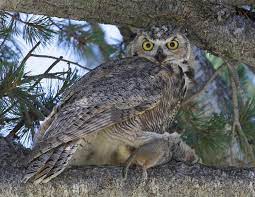Yes, owls do consume squirrels. Being opportunistic carnivores, owls use stealth, acute senses, and strong talons to ambush many small prey animals—that includes squirrels. Although not all owl species are capable of taking down such nimble quarry, larger owls such as the Great Horned Owl and Barred Owl are more than up to the task. Their power to creep up in silence and attack during the night puts them at a great advantage, particularly when squirrels are asleep or unaware. This predator-prey relationship emphasizes the owl as a primary nocturnal predator in much of the forested and suburban biome.
Owl Species That Typically Consume Squirrels
A number of owl species can hunt squirrels. Their success is determined by their size, hunting skills, and location. The following is a straightforward elucidation of the most prominent squirrel-hunting owls:
1. Great Horned Owl (Bubo virginianus)
• Distribution: Commonly distributed in North and Central America
• Size: One of the largest and strongest owl species in North America
• Typical Prey: Eastern gray squirrels, red squirrels, fox squirrels
• Hunting Characteristics:
– Has very powerful talons that kill adult squirrels
– Hunts mainly at night with stealth and high points
– Famous for its aggressive and flexible hunting tactics
2. Barred Owl (Strix varia)
• Distribution: Central and eastern North America
• Size: Large to medium
• Typical Prey: Juvenile or small squirrels, other small mammals
• Hunting Characteristics:
– Has a preference for dense woods and urban woodland edges
– Hunts by ambushing, usually at night
– Less strong than the Great Horned Owl but still efficient in appropriate habitats
3. Northern Hawk Owl (Surnia ulula)
• Distribution: Boreal woods of North America and Eurasia
• Size: Medium with long tail
• Typical Prey: Small mammals, sometimes squirrels
• Hunting Characteristics:
– Diurnal (active during the day), coinciding with squirrel activity
– Employing keen vision to track prey at far distances
– Hunts more in a hawk fashion, with rapid, straight-line flights
4. Eurasian Eagle-Owl (Bubo bubo)
• Distribution: Common throughout Europe, Asia, and parts of North Africa
• Size: One of the largest owl species in the world
• Typical Prey: Squirrels, rabbits, hedgehogs, and on some occasions small foxes
• Hunting Characteristics:
– Very strong with a wide wingspan and powerful talons
– Hunts in diverse habitats such as forests, rocky terrain, and open woods
– Can catch and transport large prey over distances
How Owls Affect Squirrel Behavior
Yes, owls can affect squirrel behavior and actually chase them away under some circumstances. The effectiveness does depend on a variety of factors.
1. Natural Predator-Prey Dynamics
• Owls are natural predators of squirrels, particularly at twilight and dawn when both are active.
• Squirrels are most exposed when on the ground, since owls can glide down silently to grab them.
• Such a predatory association induces squirrels to show fear reactions, like evasion from places having owls.
2. Squirrel Behavior and Adaptability
• Squirrels are extremely adaptable and might not necessarily be discouraged by owls’ presence, particularly if food supplies are plentiful.
• In cities, squirrels tend to acclimatize to human presence and might not regard owls as imminent threats.
3. Effectiveness of Owl Decoys
• Decoys owls can be employed to simulate the presence of owls and scare off squirrels.
• Decoys, though, may frighten away squirrels at first, but the efficiency is lost over time as squirrels become accustomed to the fixed objects .
• In order to sustain deterrence, it is suggested that decoys be moved on occasion and in addition used with other deterrent techniques.
4. Hunting Habits of Owls
• Owls are primarily nocturnal, whereas squirrels are diurnal, so there is little overlap in active periods.
• Nevertheless, at dawn and dusk, the overlap becomes greater, and owls can potentially hunt squirrels better during these periods.
Can Squirrels Hide From Owls at Night?
• Squirrels hide using natural cover:
Squirrels roost in leaf nests (dreys) or tree hollows at night, which keep predators such as owls out.
• Leaf nests and tree hollows provide security:
These are high in trees and heavily camouflaged, so owls cannot see or get to squirrels when they are active at night.
• Nests are constructed to shield:
Leaf nests consist of twigs, leaves, and moss, and tree hollows are holes in trunks or branches which naturally occur, both providing warmth and shelter.
• Owls prey primarily by stealth:
Owls use stealth and quiet flight to attack prey, but squirrels in nests or hollows are normally secure.
• Squirrels are unprotected when away from shelters:
Squirrels on the ground or foraging before dusk are more at risk and become an easy target for owls.
• Younger squirrels are more at risk:
Less experienced and younger or smaller squirrels are more susceptible to owl attacks.
• General safety hinges on remaining concealed:
Squirrels successfully evade predation by owls through the employment of safe roosting and reduced nighttime activity beyond nests.


Related Post
- Can Owls Move Their Eyes – Read The Answer
- How Much Can A Owl Carry – Read This Explanation
- Flammulated Owl : A to Z Guide
- Rufous Legged Owl : Everything You Need To Know
- Greater Sooty Owl : A to Z Guide
Resources
kidzfeed.com

